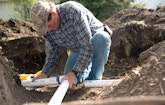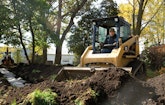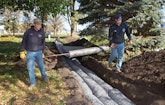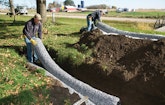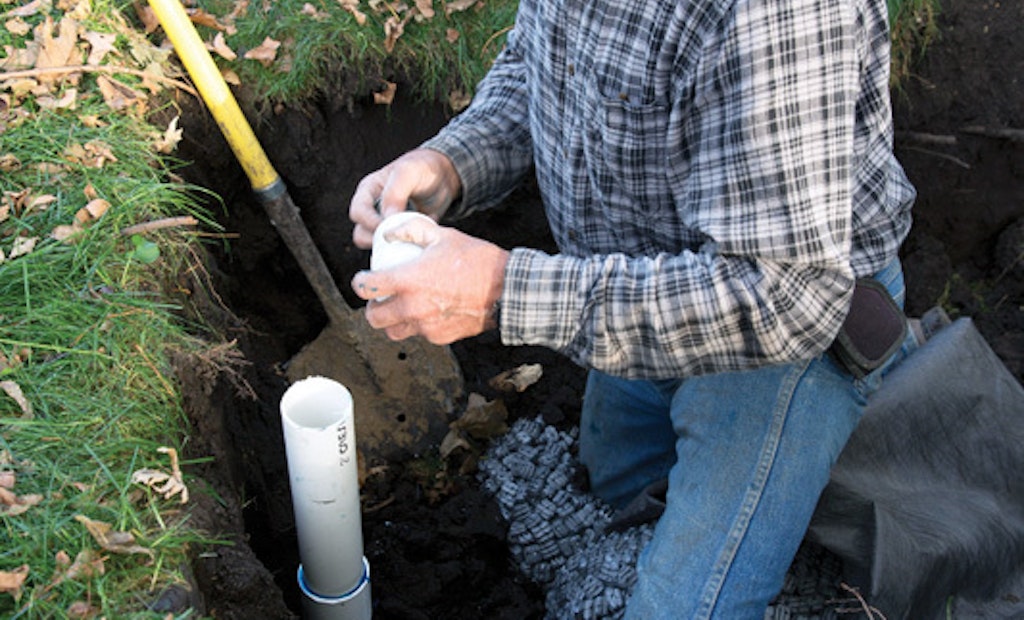
Interested in Pumps?
Get Pumps articles, news and videos right in your inbox! Sign up now.
Pumps + Get AlertsStanding on concrete all day working as foreman in a tool and die department convinced Tim Rozendaal that he wanted to be free of time clocks by age 40. His wish was granted ahead of schedule. In 2005, his father, Norm Rozendaal, asked him to join Norm Rozendaal Tiling, the company he had begun in 1976. Tim, then 35, returned to Monroe, Iowa, and embraced his future.
“Dad took the field drainage work because the tiling season lasts about 40 days in the spring and fall,” says Tim. “During the summer, he’d install two or three aerobic treatment units per month and maintain the service contracts. I was to assume responsibility for the septic branch and expand it.”
Guided by the principles of installing quality products for longevity and the correct system for the soils, Rozendaal built on the company’s history of serving local communities. Today, his team installs 35 to 45 residential systems annually and holds 130 maintenance contracts from different ATU manufacturers. In 2014, Rozendaal’s son, Justin, joined the company after graduating from college and certifying as an installer.
“It’s been rewarding for Dad and me to see the third generation secure the company’s future,” says Rozendaal. “Justin has a passion for the work and cares deeply about what he does. We’re grooming him to begin making major decisions.”
Happy Customers
Rozendaal entered the business understanding grade from installing tile with his father, but mentor and onsite installer Keith Davis shared his secrets for success. According to him, almost everyone was looking for quick and easy, but those who searched for the most productive system with the greatest longevity would reap success.
“I was very interested in pressurized sand filters because our most recent revised septic code recommended them as a second-choice option,” says Rozendaal. “Furthermore, pressurization enabled me to move systems to wherever homeowners wanted them. I was making customers happy and giving them the best value for their money. However, I wasn’t making a profit because I was always the low bidder.”
Davis encouraged Rozendaal to evaluate his situation and charge what he was worth. “I realized I didn’t need more practice installing sand filters,” says Rozendaal. “The septic branch had a full service board, the office phone rang, referrals came from customers and contractors, and I landed every quoted job — all without advertising.”
Raising his rates enabled Rozendaal to schedule the replacement of equipment and choose homeowners committed to an onsite design.
“Education is key,” he says. “I visit sites with clients more than once to ensure they understand what components are required, where they will go, and what can be moved during the design phase.” Once homeowners accept the plan, they and general contractors appreciate that Rozendaal’s initial quote remains unchanged more than 95 percent of the time. It enables homeowners to budget, and contractors to schedule the money allocated to their bid for building homes.
Davis had convinced Rozendaal that sand filters were the best solution for the area’s loamy soils with occasional heavy clay, and those systems comprise 75 percent of his annual residential installations. The work is 80 percent new construction and 20 percent repairs.
Rozendaal uses chambers or EZflow drainage bundles (Infiltrator Water Technologies) in the sand filters. When specified, advanced treatment units are usually Whitewater models (Delta Environmental Products). His installation team includes Justin Rozendaal and laborer Rick Beyer. The company’s other five employees include Norm Rozendaal and his drainage crew, and the office staff. Norm’s crew also installs two to five onsite systems a year.
Different Perspectives
For many years, state regulators regarded chambered drainfields as the definitive onsite wastewater solution, provided they weren’t installed deeper than 3 feet. Rozendaal, however, was leery of this view and he didn’t believe in percolation tests. “When I was installing drain tiles 4 feet deep, I often saw three different soils from the top down,” he says. “I learned which soils didn’t drain because I was putting tiles in them.”
Rozendaal’s practice of occasionally hiring soil scientists to take core samples at some sites quickly advanced to sampling every site. He relies on James Carroll, P.E., from the USDA-Natural Resources Conservation Service, and Mark McMurphy, P.E., from Abaci Consulting.
“Jim and Mark tell me the depth of the limiting layer and seasonal high water table,” says Rozendaal. “Then they give me an excavation depth and the chambers go 3 feet above it. Now we know we’ve done our best to avoid early system failures.”
Poor soils cause most systems to fail their time-of-transfer inspections. When they became law in 2009, Norm and Tim certified together.
“Doing inspections is not a moneymaker, but it opens the door to septic work if handled correctly,” says Tim. “Homeowners with failed systems ask many questions, including, do we install? I inspected 39 systems in 2016, four were in failure, and three bids were accepted.”
Fine-Tuning Simplicity
Inspections not only increased repair work by 10 percent, they often proved educational for Rozendaal and his crew. “Seeing many different systems and other installers’ work has changed the way we install and the products we buy,” he says. “Occasionally, it has even motivated us to try something new.”
While not related to inspections, one example of trying something new improved the ease and ability to maintain pump stations. Instead of mounting the water level floats and alarm floats on the pump pipe, Rozendaal listened to CEU instructors when they suggested using float trees.
“I liked the idea, but couldn’t see buying float trees when all we needed was PVC pipe,” says Rozendaal. “We mount the floats on one pipe and the alarms on another, then adhere the pipes inside the riser away from the pump pipe. On the pump pipe, we use PVC unions instead of Fernco flexible couplings because they aren’t pressure rated. This approach makes diagnosing problems and maintenance easier.”
Rozendaal also switched from using pumps to siphons (Fluid Dynamic Siphons). Although done mainly for ease of installation, removing as many mechanical components as possible made systems simpler and easier for homeowners to maintain. “Siphons increase the sand filter’s square footage slightly, but they are giving really good results,” he says.
Diversifying Workload
When needed, Rozendaal still does drainage work, which comprises 50 percent of the company’s annual revenue. Septic makes up the other half.
In 2005-’06, the drainage branch reached a milestone when it was subcontracted to install underground drainage to divert runoff from roofs to storm sewers. Norm, Tim, Rick and laborer Denny Sergeant worked at DuPont Pioneer, a large producer of agricultural hybrid seeds. “We had to take their safety training and abide by OSHA rules while on the property,” says Tim Rozendaal. “The lessons we learned made us think about safety methods and how important it is to go home to our families every night.”
Foremost on the Pioneer job was renting a trench box, something the crew hadn’t used before. Back home, Rozendaal bought a Speed Shore Corp. box and fabricated a trailer for it, then offered the mobile unit to nearby cities for free. “We’d watched a video about cave-ins and had discussions with people involved in them,” he says. “I didn’t want that happening to anyone.”
Residential installs are the company’s bread and butter, with commercial systems comprising only 5 percent of the work. Those systems are for facilities storing specialized industrial equipment. The units have a restroom and maybe a small office, but people rarely work in them for long. Consequently, flows are low.
“We typically installed a 2,000-gallon, three-compartment precast septic tank with effluent pump pumping to a 600 gpd Ecoflo Coco Filter (Premier Tech Aqua),” says Rozendaal. “Treated effluent surface discharges more than 100 feet to a dry retention pond. The challenge on these sites is working around all the underground utilities.”
Rozendaal also maintains the systems and sends the effluent for testing twice a year. The latest results revealed a system installed a year ago wasn’t achieving proper treatment. “On-demand pumping was channeling effluent too quickly through the biofilter,” he says. He installed a time-dosing control panel to slow the flow.
Skilled Equipment Operator
Another source of income comes from the Rozendaal family’s work and equipment being well known in the small communities surrounding Monroe. When residents on municipal sewers have wastewater problems, their friends often refer them to the guys with the backhoes. The most common occurrences are root intrusion in the lateral or the pipe failed. Many do not have clean-outs.
A subcontractor inspects and cleans the line, then gives Rozendaal the location of the obstructions and depth of the pipe. “Now I can help homeowners make informed decisions,” he says. “If possible, we repair the affected area and install a PVC clean-out. Sometimes we replace the lateral because an 80-year-old maple tree is sitting on bell clay or Orangeburg tile.”
Despite a full service board, Rozendaal made time to join the Iowa Onsite Waste Water Association, become a board member and finally its president in 2015. That year also marked the first time he served as assistant installer trainer with Sara Heger, Ph.D., of the University of Minnesota. “I lost count of the nights I spent memorizing the PowerPoint slides and practicing the accompanying script,” he says. “I was pleased to see myself improve as a trainer with each two-day session.” He did two more in 2016.
Rozendaal is a firm believer in attending the annual IOWWA conference and WWETT Show for their educational value, but he isn’t beyond having some fun. In 2014, he won first place in IOWWA’s Roe-D-Hoe competition and set the state record of one minute, seven seconds. A month later, he competed against 11 other finalists at the National Backhoe Roe-D-Hoe in Indianapolis. “I came in seventh against Avery Zahn’s combined time of 55 seconds,” says Rozendaal.
Bright Future
Besides septic work and drainage tile, the third element in the Rozendaal corporation is the 400-acre operation raising mostly row crops. The farm is home to the company’s shop with three service bays and office. Equipment and components are stored in two Morton pole buildings and two Cover-All hoop buildings.
Septic components include Tuf-Tite products, 1/3 hp and 1/2 hp Barnes (Crane Pumps & Systems) pumps, Roth Global Plastics plastic septic tanks, and a grade laser (Spectra Precision).
Equipment includes:
- J C Bamford 4CX rubber tire backhoe
- JI Case 590 N Series backhoe
- John Deere 160 track hoe
- Caterpillar 247 B3 and 257 skid-steer loaders
- Two John Deere 850 bulldozers
- Caterpillar D5 bulldozer with six-way blade
- Freightliner F70 dump truck with HilBilt dump body
- Sterling dump truck
- Caterpillar 304 mini-excavator
- Scheef H16 mini-excavator
- B & B 14,000-pound skid-steer loader trailer
- Kiefer 14,000-pound skid-steer loader trailer
- Trail King 24,000-pound trailer
- Jet 40,000-pound trailer
The future looks bright for the Rozendaals. The onsite branch expanded by 40 percent since 2010, and even greater growth is on the horizon. “Housing developments in the bedroom towns of Adel and Waukee west of Des Moines have gone crazy,” says Rozendaal. “I don’t mind driving 60 miles one way because the competition can’t handle all the work. They’ll be plenty to go around and everyone will prosper.”
Knocking things over
Onsite work and laying drain tile dominate the service board at Norm Rozendaal Tiling in Monroe, Iowa, but occasionally demolition jobs find their way into the rotation.
“It comes with the territory,” says co-owner Tim Rozendaal. “Often trees or tree stumps are in the way of the wheel trencher. Silos become obsolete or are attractive nuisances on deserted farms. We answer the call when they have to go.”
He works with dynamite expert Alan Beyer. He blows up the target, then Rozendaal and his team move in with backhoes and dump trucks to remove the rubble. If possible, organic materials are bulldozed into a trench, covered, and left to decompose.
Their most challenging and dangerous demolition project was razing the Sully Coop wood feed mill in August 2007. “Alan told me it would be a 10-day job, but we were there for 60 days,” says Rozendaal. “The building was 140 feet tall with the main structure 80 feet above the pavement. We knocked it down bit by bit to prevent the structure from collapsing into the surrounding buildings or endangering people. It was harvest season, and the yard was a constant state of activity with trucks coming and going. The work was very tricky.”

